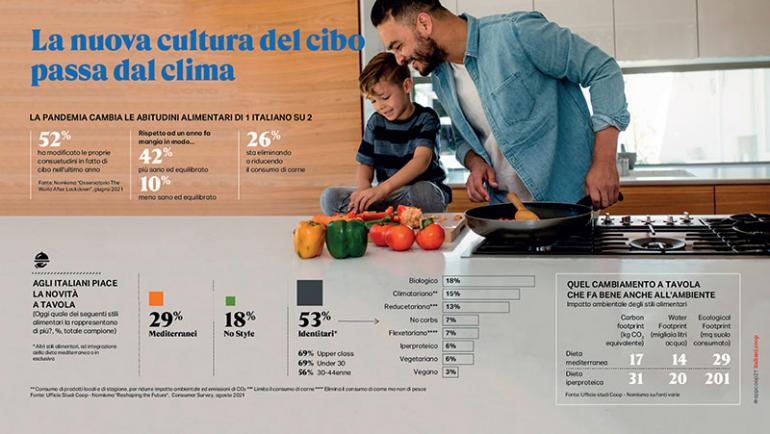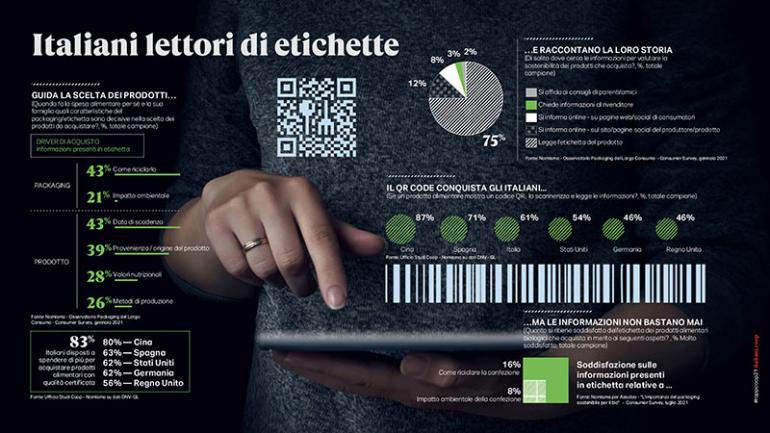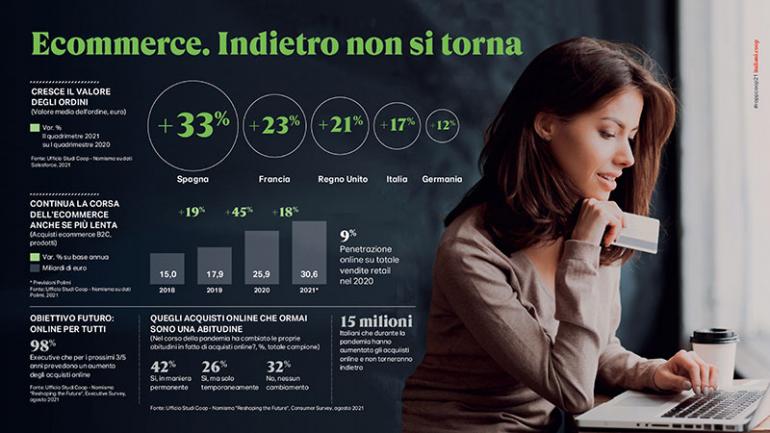Environment and health at the Italian dinner table
After the worst crisis of all time, the best recovery ever. The pandemic gives us a growing world, multipolar, engaged in an obstacle course towards the goal "zero emissions". Health and environment are the values that guide the food choices of Italians after the lockdown: 88% associate food with the concept of sustainability.
The scenario outlined in the Coop Report 2021 "Economy, Consumption and Lifestyles of Italians of Today and Tomorrow" gives us a picture of an Italy undoubtedly transformed by the pandemic.
Italians are coming out of the "bubble" that has imprisoned them since the beginning of last year and are finally giving new shape to their future, accelerating changes and choosing new priorities.
In Europe and in the world, the country is experiencing a second youth; it is growing faster than expected (the leap forward in GDP could reach 6%), driven by exports that have already exceeded pre-Covid levels and by the digital conversion of its manufacturing.
To reinforce the positive sentiment, the global economic scenario, growing at a faster pace than expected: the changes in world GDP are all upward and stand at +6% in 2021 but the trend is expected to continue in the years to come (+4.9% in 2022 and +3.5% in 2023).
Specifically, on the basis of the IMF's short- and medium-term forecasts, China will be the world's locomotive in the coming years, with an estimated GDP growth of +8.1% in 2021 and +5.7% in 2022. This is followed, in equal measure, by the United States and the United Kingdom with +7% in 2021 and then the countries of the Eurozone (+4.6%), Russia (+4.4%) and Japan (+2.8%). Within the Eurozone, the Spanish economy, while growing the most in 2021, will take the longest to return to pre-crisis levels.
In Italy and around the world, however, the return to growth strongly reiterates the pressing need for a major green revolution at global level (44 countries have committed to laws, protocols, documents in 2021 compared to 22 just two years ago); indeed, time seems to be running out, so much so that new geopolitical tensions due to the decrease in available natural resources are feared (80% of executives interviewed fear this).

Very controlled diet
Health and environment are undoubtedly the values that guide the food choices of Italians after the lockdown: 4 out of 10 people eat in a healthier and more balanced way than a year ago with a strong focus on "zerowaste" (7.4 million Italians). If only 18% do not recognize themselves in any food culture and 24% refers only to the Mediterranean diet, more than half of Italians identify themselves with organic, veg&veg, gourmet, high protein and low carbs diets, but the real novelty of 2021 is the appearance of the "climatarians", or those (1 Italian out of 6) who declare to adjust their diet to reduce environmental impact. In fact, the environment becomes a reference point for many: 88% associate food with the concept of sustainability, which for 33% means having a respectful production method, for another 33% attention to packaging, for 21% it is synonymous with origin and supply chain and for 9% ethical responsibility.
Food understood as wellbeing and health is another driver fuelled by the pandemic: 83% say they are willing to spend more in order to buy products with certified quality (followed by the Chinese with 80% and only after Europeans and Americans). The success of market segments such as free-from and rich-in confirms this.
Which brands enter the shopping cart
More and more Italians are choosing food brands and brands that are attentive to the protection of the environment, the community and the territory. In the first six months of 2020 the value of the "green" trolley reached 10 billion euros (+8% compared to the previous year). In the first half of 2021, 70% of Italians bought food and beverage products of brands active on the theme of environmental sustainability, 62% oriented their choice towards brands that adopt credible green choices and not just marketing, 60% bought products of companies committed to social sustainability.
According to 33% of Italians, a food product is sustainable when it is obtained with an organic production method, while a similar percentage associates sustainability with packaging that must be made with eco-friendly materials, without plastic and without excessive packaging.
However, if 46% of Italians say they are willing to spend more to bring to the table a food product with sustainable characteristics, 54% would pay nothing or almost nothing more than for a conventional product.
Label, the business card of products
Growing wellbeing also explains the greater attention paid to the label; thus, indications on the origin and provenance of food are decisive for the purchase for 39% of the population, for 28% the nutritional values and then (26%) the production method.
In short, Italians are less and less likely to delegate their choices to an unconditional trust in the brand and are less willing to pay for pure image content. A phenomenon, this, of the progressive decline of the brand that has been going on for some time, made evident not only by the advent of discounters (today 20% of large-scale retail sales) but also by the crisis in other channels of modern distribution (from 2013 to today the loss of share of big brands is equal to a -9%) counterbalanced by Mdd (a +9% in the same period of time) and also by small producers (+3%), evidently faster in intercepting the new changing needs of consumers.

E-food slows down
After the boom of the year of the pandemic, the growth of online food is slowing down. Although it is gaining market share, it is still a marginal component of food sales.
Egrocery closed 2020 with over €1.3 million in sales and a triple-digit increase over the previous year (+123%). In the first half of 2021, growth slowed down but equally marked +46% over the same period in 2020. The outlook also looks rosy for the second half of the year and for 2022.
Despite the sudden exploit, online sales are still well below 3% of the entire FMCG market.
The growing trend of Click&Collect is reconfirmed also in 2021, which in the first half of 2021 comes to weigh 17% of the entire consumer packaged goods ecommerce (+9% market share compared to 2019).

Ready for the food revolution
The "Reshaping The Future" survey curated by the Coop and Nomisma Studies Office shows that 76% of Italians are ready for a food metamorphosis by 2030.
New lifestyles (32%), technological innovation (26%) and above all climate change (35%), will be the drivers of change. In addition to sustainable, organic, plant-based and ready-to-eat foods, according to 26% of respondents the key word will be "food revolution" (plant-based foods with the taste of meat, based on algae, insect meal and meat grown in vitro), a reality already underway, so much so that in 2020 alone investments have reached 6.2 billion euros.

The trend of food consumption
Unlike the total consumption that will recover the precovid levels only in 2023 (43% of executives say so), for domestic food expenditure Italians imagine to return already in 2022 to the same levels before the pandemic. On the other hand, outdoor food consumption is still lagging behind. The trend of food sales in the summer months 2021 confirms a significant progress compared to the same period in 2020 (+2.8%) and 2019 (+3.4%).
Growing with greater intensity are mainly beverages (+5.5% var % 2021-2019) and frozen food (+6%). On the other hand, the increase is more limited for fresh products in fixed and variable weights (+2.7%).
With reference to consumer packaged goods only, the greatest contribution to food growth recorded in June and July 2021 (compared to the same period in 2019) is provided by comfort food and all those food products that describe a greater presence (convivial) at home: sliced meats, alcoholic beers, sparkling wine, alcoholic aperitifs. The growth of fish-based products is also confirmed.



















